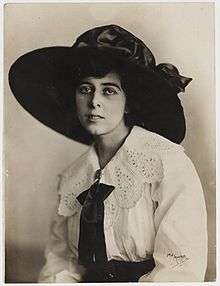Mirrie Hill
| Mirrie Hill | |
|---|---|
 | |
| Born |
1 December 1889 Randwick, N.S.W |
| Died |
1 May 1986 St Leonards, N.S.W. |
| Occupation | Composer |
| Spouse(s) | Alfred Hill (married 1921 – 1960) |
Mirrie Irma Hill (née Solomon) OBE (1 December 1889 – 1 May 1986) was an Australian composer.
Early life
Mirrie Irma Jaffa Hill was born on December 1, 1889 in Randwick, Australia. She was the youngest of three, born to Levien Jaffa Solomon and Kate Caroline.[1] She had a good ear early on, detecting dissonance and running out of the room whenever her aunt would play Mendelssohn’s Songs Without Words.[2] Hill studied composition with Alfred Hill, who would later become her husband, at Shirley School, Edgecliff. With Alfred Hill as conductor, Godfrey Smith and the Sydney Amateur Orchestral Society performed Mirrie Hill’s first orchestral work, Rhapsody for Piano and Orchestra, in 1914 at the Sydney Town Hall. Hill was unable to study in Germany because of World War I, so she instead went to the New South Wales State Conservatorium of Music, where she was awarded a scholarship by the director, Henri Verbrugghen.[1]
Career
After finishing her schooling at the Conservatorium in 1918, Hill was made assistant-professor of harmony, counterpoint and composition there. After retiring from the Conservatorium in 1944, Hill worked as an examiner for the Australian Music Examinations Board from 1959 to 1966.[1] Hill’s exploration into music inspired by the indigenous peoples of Australia, started when anthropologist Charles P. Mountford asked Hill to compose the score for the film he was making about Aboriginal life. For inspiration, Mountford gave Hill recordings he had made of performances of indigenous Australian songs. Hill drew from these recordings for both her suite Three Aboriginal Dances and Arnhem Land Symphony. Although the indigenous songs influenced Hill’s Symphony, she has explained that the symphony was not meant to be specifically Aboriginal in its make-up.[3] Mirrie Hill described her own music as “not [in] the very modern idiom but entirely individual as to style and content.”[1] Hill composed in many different genres, but her favorite was classical orchestra music.[3] She created over five hundred pieces throughout her life, spanning from chamber music and film scores to elementary works for children.[4] Although she did create many longer pieces of music for orchestra and ensembles, Hill became known as a miniaturist because a great deal of her published works were short.[1]
Personal life
In 1921, she married her previous teacher, Alfred Hill who had three children from a previous marriage. Hill never had any children of her own. They were married in Mosman, New South Wales and built a home there, where they lived for most of their lives.[1] Due to the fact that Alfred Hill was such a recognized composer, Mirrie Hill’s work was often overlooked as she took a back-seat to her husband’s career.[2] She was described by the people around her as a shy and happy person; she put her husband’s career before her own for most of her life. Hill was given greater recognition for her works after her husband’s death.[1] In 1975 she was made a life member of the Fellowship of Australian Composers and in 1980 OBE (Officer of the Most Excellent Order of the British Empire).[2]
Works
Hill composed for orchestra, chamber ensemble, choral pieces, film scores, songs and solo instrumental works. She often incorporated Aboriginal themes and traditional Jewish melodies. Selected works include:
- Rhapsody for Piano and Orchestra (1914)
- The Leafy Lanes of Kent (1950)
- Three miniature pieces for the piano
- Three Aboriginal Dances (Brolga, The Kunkarankara Women, Nalda of the Echo) (1950)
- Arnhem Land symphony (1954)
Her works have been recorded and issued on CD, including:
- Dance of the Wild Men - Early 20th Century Australian Piano Music Artworks
Additional works include:[5]
- Meditation (1954)
- March of a Robot (1973)
- Dance of the Cunning Mouse (1973)
- My Bird Sings (1973)
- Merry Imp (1976)
- Come Summer (1969)
- Three Nice Mice (1970)
- Pipe Reel (1970)
- Child Fantasies (1935)
- Garden Sketches (1934)
- Mr. Roo (1948)
- Bell Birds (1952)
- The Dancing Fawn (1969)
- Party Tunes (1957)
- All In a Day (1950)
- Three Highland Tunes (1971)
- Dancing Feet (1950)
- Willow Wind (1973)
- Lost- my little black puppy: he scampers away (1949)
- For Hire (1949)
- Dreams (1942)
- Waltz (1942)
See also
References
- 1 2 3 4 5 6 7 "Biography- Mirrie Irma Jaffa Hill". Australian Dictionary of Biography. 2016. Retrieved 2 December 2016.
- 1 2 3 Wright, Simon. "Mirrie Hill - Australian recordings". Move Records. Retrieved 2016-12-02.
- 1 2 "ABC Classic FM - Australian Music - Symphony in A, Arnhem Land". ABC Classic FM. Retrieved 2016-12-02.
- ↑ Rowena, Pearce, (2002-01-01). "Rediscovering Mirrie Hill (1889-1986): composer in her own right".
- ↑ "State Library of Victoria search - mirrie hill". search.slv.vic.gov.au. Retrieved 2016-12-02.
Further reading
- "Hill family - papers, music and pictorial material of Alfred Hill and Mirrie Hill, 1854-1984". Manuscripts and Pictures Catalogue, State Library of NSW.